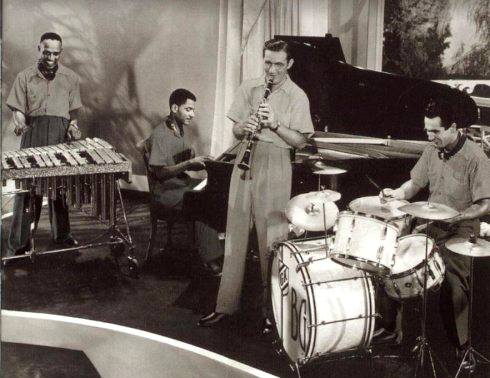When "swing was the thing," big bands led by the Dorsey brothers, Count Basie, Benny Goodman, Artie Shaw and Duke Ellington ruled America’s airwaves and its dance floors. But even at the height of big band mania, small ensembles often stole the show. Hot, small combos turned the tables on 'big band supremacy' when dance band spin-offs began to top the charts. Goodman had his Trio and Quartet; Tommy Dorsey, his Clambake Seven. The Crosby Band had the Bob Cats. And Artie Shaw, his Gramercy Five.
In his biography of Benny Goodman, Swing, Swing Swing, author Ross Firestone notes, "...although the big bands gave the Swing Era its commercial popularity, it was casually assembled small group sessions like these that produced much of its inspired music."
Benny Goodman paved the way with his ground-breaking 1935 Trio recordings with drummer Gene Krupa and pianist Teddy Wilson. For his first 'small group' session, Goodman chose 'standards' that were already well-known vehicles for jazz. The emphasis was on pure jazz improvisation without the formal and sometimes ponderous arrangements needed to organize a big band of more than a dozen players and singers. The initial success of the Trio encouraged Goodman to keep small combos in his act throughout his career, augmenting the Trio to a Quartet, Sextet or Septet.
Artie Shaw, one of the most danced-to bandleaders of the Swing Era, was slow to form a small ensemble out of his orchestra. But when he did in 1940 he came up with something entirely new. Dubbed the Gramercy Five after a New York telephone exchange, Shaw’s small-combo-jazz was crafted like chamber music but had the excitement of hot jazz. And Shaw added the unusual sound of the harpsichord to the rhythm section. The very first Gramercy Five session produced a million-selling record. It was a number Artie Shaw composed and titled after the street in Los Angeles where all their rehearsals had taken place—"Summit Ridge Drive."
The nucleus of the popular Bob Crosby Orchestra was the Bob Cats, an eight to ten piece ensemble. The distinctive sound of the Bob Cats was molded by a shared reverence for the free-wheeling, foot-loose sound of classic New Orleans-style hot jazz. And the Bob Cats added an extra solo voice to the traditional front line—New Orleans saxophonist Eddie Miller.
Because of his close association with members of the Bob Cats early in his career, Jim Cullum finds inspiration for his group's musical concept from their timeless 1930s' small-band recordings like "Dog Town Blues," "Mournin' Blues," and "All By Myself."
Tommy Dorsey attracted a mass audience fronting his big band, which pledged to play a "song for every taste." But The Sentimental Gentlemen of Swing could turn on a dime and play the hot swing style of New Orleans jazz he loved with his small combo, the Clambake Seven. A featured player in the band was the innovative and much admired saxophonist, Bud Freeman.
Duke Ellington was another big band leader who made a career-long habit of experimenting and recording with small combos. Some small group sessions were under his own name, but many were led by one of his own sidemen, including a winter 1940 session on which Ellington played piano with Cootie Williams and his Rug Cutters.
This week on Riverwalk Jazz The Jim Cullum Jazz Band remembers the small, hot combos of the Swing Era with music from their repertoires including, "At the Codfish Ball" from the Clambake Seven, "Summit Ridge Drive" from the Gramercy Five, "Moonglow" from the Goodman Quartet with Lionel Hampton on vibes, and the Ellington small groups with a composition by Cootie Williams, "A Toasted Pickle." Special features on the broadcast include an interview with Goodman small group personnel--pianist Teddy Wilson and vibist Lionel Hampton.
Photo credit for Home Page: Benny Goodman Quartet, 1938. Photo courtesy lionelhampton.nl.
Text based on Riverwalk Jazz script by Margaret Moos Pick ©2012






